Art
3 Artists on the Role of the Caribbean in Environmental Art
|
|


Leanne Russell, The Spirits of Abaco, 2021. © Leanne Russell. Courtesy of the artist.
With a communal history of being “discovered” through Euro-American colonialism, the Caribbean bears the geographic memory of the horrors of the transatlantic slave trade. Even after the abolition of slavery, Euro-American colonization continued through extraction of resources. The Caribbean, therefore, is in a unique position to help understand the afterlife of colonization and how it shapes the global response to climate change.
For artists from and working in the Caribbean, climate change threatens to eradicate not only the archipelagic landscape, but also the cultural memories of those communities. For example, Deborah Jack, Anina Major, and Leanne Russell draw on the Caribbean landscape by redressing the trauma of colonial extraction.
This ongoing extraction by multiple countries (sometimes on the same island) created schisms across identity and communities that defined what scholar Édouard Glissant called an “archipelagic thinking.” For Glissant, the unpredictability and multiplicity of the Caribbean were distinctively tied to its history and geography; now, those same traits are the building blocks for thinking critically about restoration in an environment whose future feels uncertain.




Advertisement
For Jack, Major, and Russell, their work is an opportunity to show audiences a lived experience of the Caribbean that maintains its cultural memory. Their work challenges the images of the Caribbean as purely a tourist destination environment. These artists use photography, ceramics, and installation to create works that layer ecological trauma (both metaphorical and literal) with the impact of colonialism on climate change, while pointing to alternative, possible, futures of survival for the next generation.
As we celebrate Earth Day, and look at ways that artists consider the environment in their work, Artsy highlights three artists who reference the Caribbean in their practice to unearth fresh conversations on climate change.
B. 1981, Nassau, the Bahamas. Lives and works in New York.




Portrait of Anina Major by Melissa Alcena, 2022. Courtesy of the artist.
Anina Major is an artist working in installation and sculpture, primarily through the medium of ceramics. Her work examines the memory of the land, in particular how it can trigger personal memories, creating a never-ending examination between self and place. By using craft techniques, Major hopes to reclaim and rebuild experiences by evoking displaced objects into her ceramic forms. “There is a poetic parallel between my work and lived experiences; moments of vulnerability placed under challenging circumstances evolving to a permanent, yet fragile state,” she said. “The ceramic process, as a metaphor, lends itself beautifully to these feelings of loss and gain.”
Major likens cultural memory to ecological memory. Having lived in an extreme low-elevation coastal zone, where the coast is always in danger of shifting, Major is well aware of the immediate threat and changes of climate change. In her work, Major turns to preserving cultural practices of those communities that are in danger of disappearing, practices that she believes are just as important as the biological and infrastructural concerns. This can be seen in her intricately woven, pleated ceramic sculpture jars that incorporate both the body and the landscape into their visual identity.
“Every year, I witness the straw work made by my grandmother deteriorate and can’t help but notice the metaphorical parallels between this object and threats of dissolution posed by the impact of climate change on my cultural heritage. Intimate objects created with love and care from a variety of locally-grown, biodegradable palms and plants, serve as tangible evidence of a nurtured kinship with our African ancestors and our close relationship to the land,” she said.
B. 1970, Rotterdam, the Netherlands. Lives and works in New York.


Portrait of Deborah Jack, 2022. Courtesy of the artist.
Deborah Jack works across video, collage, and photography to evoke the haunting side of Caribbean ecology. She does this by making images of storms, coastlines, and nature to emphasize how the shore is an ongoing site of departure and arrival, and “a place of embrace and erosion,” as she put it. Jack incorporates her childhood memory of Sint Maarten (where she was raised) with the larger colonial history of the island to examine how one’s cultural experience of the land is shaped by historical factors.
For example, her 2018 media installation Drawn by Water Sea Drawings in 3 Acts, Act One Wait/Weight on the Water examines the shared vulnerabilities created by climate change across geographic zones by overlaying footage of the tide on different coastlines in Sint Maarten and Scheveningen in the Netherlands onto one another. This approach to artmaking emphasizes that climate change will impact everyone, no matter where they are in the global socioeconomic hierarchy.


Having grown up with hurricanes before the advent of the Weather Channel, Jack described how her community had to rely on changes occurring in the air and the water to sense a storm approaching, which she describes as an invaluable way of learning to feel nature in order to be responsive to it. It is this embodied feeling that Jack injects into her immersive media installations. “All these experiences with nature during my formative years now intersect in my practice. [I am] thinking about what memories are embedded in the landscape and wanting to create a visual mythology around that,” she said.
“I think that [seeing] the climate apocalypse as inevitable is a function of white supremacist capitalism that believes that the world ends with them. However, we in the region have gone through several apocalyptic events and we are still here,” Jack said. “We have the power to imagine a different existence as opposed to ending.”
B. Nassau, the Bahamas. Lives and works in Green Turtle Cay, Abaco, the Bahamas.


Russell’s practice uses photography to map out generations of memory across the Caribbean. She achieves this by superimposing archival images of her home island, Green Turtle Cay (part of the Abaco islands), with contemporary images to highlight the significant ecological changes that have occurred over the past century, while also paying attention to the folklore that still survives.
Green Turtle Cay is considered a “family island” of the Bahamas, far from its capital of Nassau and thus more rural. Russell uses her work to examine how an island nation (like the Bahamas) can have its own dislocated island sites that can be overlooked, when need-based aid is dispersed following a hurricane or other climate catastrophe. Following Hurricane Dorian, which severely impacted the Bahamas, Russell began overlapping archival images from the Great Hurricane of 1932 with her firsthand photographs from Dorian and its aftermath. “The work speaks to the commonality of those two cataclysmic events, and how, eerily, nothing has changed in almost 80 years,” she said.
“Many people never come face-to-face with the effects of climate change. For people in the Caribbean and island countries in general, climate change and global warming are real life issues that affect daily lives, and threaten their future and the future of their island homes. We see the tides ebb and flow on a daily basis and feel the effects of them as sea level rises and storms become bigger and stronger,” she said. “While the science of climate change rings true globally, it is small, island, developing states such as the Bahamas that are on the front lines of climate-change disasters, but are powerless to reverse the crisis via their own efforts.”
Ayanna Dozier
Ayanna Dozier is Artsy’s Staff Writer.





Art
The Venice Biennale and the Art of Turning Backward – The New York Times


There is a sour tendency in cultural politics today — a growing gap between speaking about the world and acting in it.
In the domain of rhetoric, everyone has grown gifted at pulling back the curtain. An elegant museum gallery is actually a record of imperial violence; a symphony orchestra is a site of elitism and exploitation: these critiques we can now deliver without trying. But when it comes to making anything new, we are gripped by near-total inertia. We are losing faith with so many institutions of culture and society — the museum, the market, and, especially this week, the university — but cannot imagine an exit from them. We throw bricks with abandon, we lay them with difficulty, if at all. We engage in perpetual protest, but seem unable to channel it into anything concrete.
So we spin around. We circle. And, maybe, we start going backward.
I’ve just spent a week tramping across Venice, a city of more than 250 churches, and where did I encounter the most doctrinaire catechism? It was in the galleries of the 2024 Venice Biennale, still the world’s principal appointment to discover new art, whose current edition is at best a missed opportunity, and at worst something like a tragedy.
It’s often preachy, but that’s not its biggest problem. The real problem is how it tokenizes, essentializes, minimizes and pigeonholes talented artists — and there are many here, among more than 300 participants — who have had their work sanded down to slogans and lessons so clear they could fit in a curator’s screenshot. This is a Biennale that speaks the language of assurance, but is actually soaked in anxiety, and too often resorts, as the Nigerian author Wole Soyinka deplored in a poem, to “cast the sanctimonious stone / And leave frail beauty shredded in the square / Of public shame.”
This year’s Biennale opened last week under an ominous star. The Venetian megashow consists of a central exhibition, spanning two locations, as well as around 90 independent pavilions organized by individual nations. One of these nations is Israel, and in the weeks before the vernissage an activist group calling itself the “Art Not Genocide Alliance” had petitioned the show’s organizers to exclude Israel from participating. The Biennale refused; a smaller appeal against the pavilion of Iran also went nowhere. (As for Russia, it remains nation non grata for the second Biennale in a row.) With disagreements over the war in Gaza spilling into cultural institutions across the continent — they’d already sunk Documenta, the German exhibition that is Venice’s only rival for attendance and prestige — the promise of a major controversy seemed to hang over the Giardini della Biennale.
As it happened, the artist and curator of Israel’s pavilion surprised the preview audience by closing their own show, and posted a sign at the entrance declaring it would stay shut until “a cease-fire and hostage release agreement is reached.” A small protest took place anyway (“No Death in Venice” was one slogan), but the controversy had only a tiny impact on the Prosecco-soaked Venetian carnival that is opening week. Right next door, at the U.S. Pavilion, twice as many visitors were waiting to get inside as were protesting.
One could strain to read the Israeli withdrawal productively, as part of a century-long tradition of empty, vacated or closed exhibitions by artists such as Rirkrit Tiravanija, Graciela Carnevale, and all the way back to Marcel Duchamp. Probably it was the only possible response to an untenable situation. Either way, the Israel pavilion encapsulated in miniature a larger dilemma and deficiency, in Venice and in culture more broadly: a thoroughgoing inability — even Foucault did not go this far! — to think about art, or indeed life, as anything other than a reflection of political, social or economic power.
That is certainly the agenda of the central exhibition, organized by the Brazilian museum director Adriano Pedrosa. I’d cheered when he was appointed curator of this year’s edition. At the São Paulo Museum of Art, one of Latin America’s boldest cultural institutions, Pedrosa had masterminded a cycle of centuries-spanning exhibitions that reframed Brazilian art as a crucible of African, Indigenous, European and pan-American history. His nomination came a few weeks after Giorgia Meloni became Italy’s first far-right prime minister since World War II. And Pedrosa — who had successfully steered his museum through Brazil’s own far-right presidency of 2018-22 — promised a show of cosmopolitanism and variety, as expressed in a title, “Foreigners Everywhere,” that seemed like a moderate anti-Meloni dig.
But what Pedrosa has actually brought to Venice is a closed, controlled, and at times belittling showcase, which smooths out all the distinctions and contradictions of a global commons. The show is remarkably placid, especially in the Giardini. There are large doses of figurative painting and (as customary these days) weaving and tapestry arranged in polite, symmetrical arrays. There is art of great beauty and power, such as three cosmological panoramas by the self-taught Amazonian painter Santiago Yahuarcani, and also far less sophisticated work celebrated by the curator in the exact same way.
In the brutal rounding-down arithmetic of the 2024 Venice Biennale, to be a straniero — a “foreigner” or “stranger,” applied equally to graduates of the world’s most prestigious M.F.A. programs and the mentally ill — implies moral credibility, and moral credibility equals artistic importance. Hence Pedrosa’s inclusion of L.G.B.T.Q. people as “foreigners,” as if gender or sexuality were proof of progressive bona fides. (Gay men have led far-right parties in the Netherlands and Austria; over at Venice’s Peggy Guggenheim Collection is a wonderfully pervy show of the polymathic Frenchman Jean Cocteau, who praised Nazis while drawing sailors without their bell-bottoms.)
Even more bizarre is the designation of the Indigenous peoples of Brazil and Mexico, of Australia and New Zealand, as “foreigners”; surely they should be the one class of people exempt from such estrangement. In some galleries, categories and classifications take precedence over formal sophistication to a derogatory degree. The Pakistan-born artist Salman Toor, who paints ambiguous scenes of queer New York with real acuity and invention, is shown alongside simplistic queer-and-trans-friendly street art from an Indian NGO “spreading positivity and hope to their communities.”
Over and over, the human complexity of artists gets upstaged by their designation as group members, and art itself gets reduced to a symptom or a triviality. I felt that particularly in three large, shocking galleries in the central pavilion of the Giardini, packed tight with more than 100 paintings and sculptures made in Asia, Africa, Latin America and the Middle East between 1915 and 1990. These constitute the bulk of what Pedrosa calls the show’s nucleo storico, its historical core, and this was the part of the Biennale I’d looked forward to most. It had promised to demonstrate that the world outside the North Atlantic has a history of modern art far richer than our leading museums have shown us.
Indeed it does. But you won’t learn that here, where paintings of wildly different importance and quality have been shoved together with almost no historical documentation, cultural context, or even visual delight. It flushes away distinctions between free and unfree regimes or between capitalist and socialist societies, or between those who joined an international avant-garde and those who saw art as a nationalist calling. True pioneers, such as the immense Brazilian innovator Tarsila do Amaral, are equated with orthodox or traditionalist portraitists. More ambitious exhibitions — notably the giant “Postwar,” staged in Munich in 2016-17 — used critical juxtaposition and historical documentation to show how and why an Asian modernism, or an African modernism, looked the way it did. Here in Venice, Pedrosa treats paintings from all over as just so many postage stamps, pasted down with little visual acuity, celebrated merely for their rarity to an implied “Western” viewer.
You thought we were all equals? Here you have the logic of the old-style ethnological museum, transposed from the colonial exposition to the Google Images results page. S.H. Raza of India, Saloua Raouda Choucair of Lebanon, the Cuban American Carmen Herrera, and also painters who were new to me, got reduced to so much Global South wallpaper, and were photographed by visitors accordingly. All of which shows that it’s far too easy to speak art’s exculpatory language, to invoke “opacity” or “fugitivity” or whatever today’s decolonial shibboleth may be. But by othering some 95 percent of humanity — by designating just about everyone on earth as “foreigners,” and affixing categories onto them with sticky-backed labels — what you really do is exactly what those dreadful Europeans did before you: you exoticize.
And yet, for all that, there is so much I liked in this year’s Biennale! From the central exhibition I am still thinking about a monumental installation of unfired coils of clay by Anna Maria Maiolino, a winner of the Golden Lion for Lifetime Achievement, that recasts serial production as something intimate, irregular, even anatomical. Karimah Ashadu, who won the Silver Lion for her high-speed film of young men bombing across Lagos on banned motorbikes, gave the economic intensity of megacity life a vigorous visual language. There are the stark, speechless paintings from the 1970s of Romany Eveleigh, whose thousands of scratched little O’s turn writing into an unsemantic howl. There are Yuko Mohri’s mischievously articulated assemblages of found objects, plastic sheeting and fresh fruit, in the Japanese Pavilion, and Precious Okoyomon’s Gesamtkunstwerk of soil, speakers and motion sensors, in the Nigerian Pavilion.
Beyond the Biennale, Christoph Büchel’s frenzied exhibition at the Fondazione Prada assembles mountains of junk and jewels into an impertinent exposé of wealth and debt, colonialism and collecting. In the Palazzo Contarini Polignac, a hazily elegant video by the Odesa-born artist Nikolay Karabinovych reinscribes the Ukrainian landscape as a crossroads of languages, religions and histories. Above all there is Pierre Huyghe, at the Punta della Dogana, who fuses human intelligence and artificial intelligence into the rarest thing of all: an image we have never seen before.
What all these artists have in common is some creative surplus that cannot be exploited — not for a nation’s image, not for a curator’s thesis, not for a collector’s vanity. Rather than the sudsy “politics” of advocacy, they profess that art’s true political value lies in how it exceeds rhetorical function or financial value, and thereby points to human freedom. They are the ones who offered me at least a glimpse of what an equitable global cultural assembly could be: an “anti-museum,” in the phrase of the Cameroonian philosopher Achille Mbembe, where “the exhibiting of subjugated or humiliated humanities” at last becomes a venue where everyone gets to be more than a representative.
I still, unfashionably, keep faith with Mbembe’s dream institution, and the artists here who would have their place in it. But we won’t build it with buzzwords alone, and if anyone had actually been paying attention to the political discourse in this part of the world in a time of war, they would have realized that two can play this game. “An essentially emancipatory, anticolonial movement against unipolar hegemony is taking shape in the most diverse countries and societies” — did someone in the 2024 Venice Biennale say that? No, it was Vladimir Putin.
Art
Turner Prize shortlist includes art showcasing Scottish Sikh community
|
|
A Scottish artist who uses cars, worship bells and Irn-Bru in her work is among the nominees for this year’s Turner Prize.
Glasgow-born Jasleen Kaur’s work reflects her life growing up in the city’s Sikh community.
She is up for the prestigious art award, now in its 40th year, alongside Pio Abad, Claudette Johnson and Delaine Le Bas.
Turner Prize jury chairman Alex Farquharson described it as a “fantastic shortlist of artists”
Works by the nominated artists will go on show at London’s Tate Britain gallery from 25 September.
They will receive £10,000 each, while the winner, to be announced on 3 December, will get £25,000.
In a statement, Farquharson said: “All four make work that is full of life.
“They show how contemporary art can fascinate, surprise and move us, and how it can speak powerfully of complex identities and memories, often through the subtlest of details.
“In the Turner Prize’s 40th year, this shortlist proves that British artistic talent is as rich and vibrant as ever.”
The shortlisted artists are:
Pio Abad
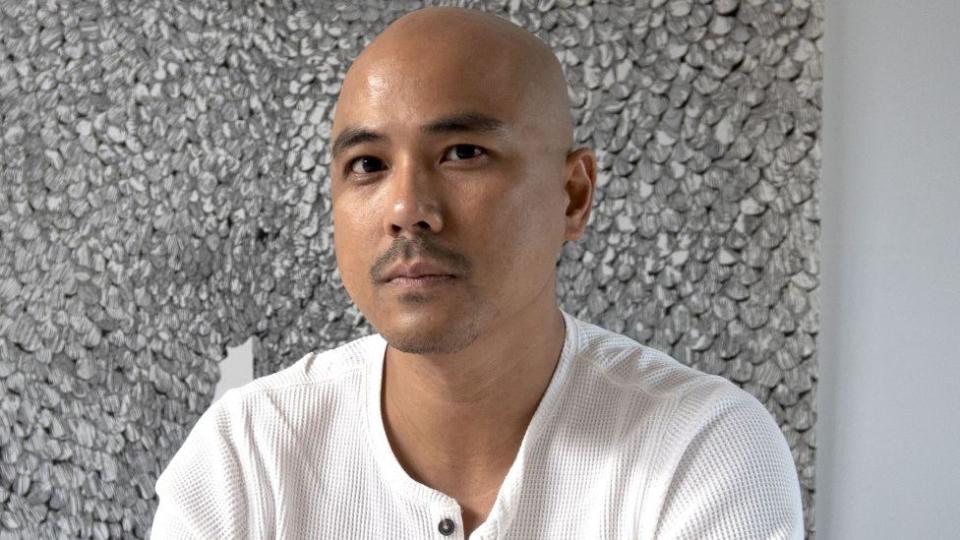

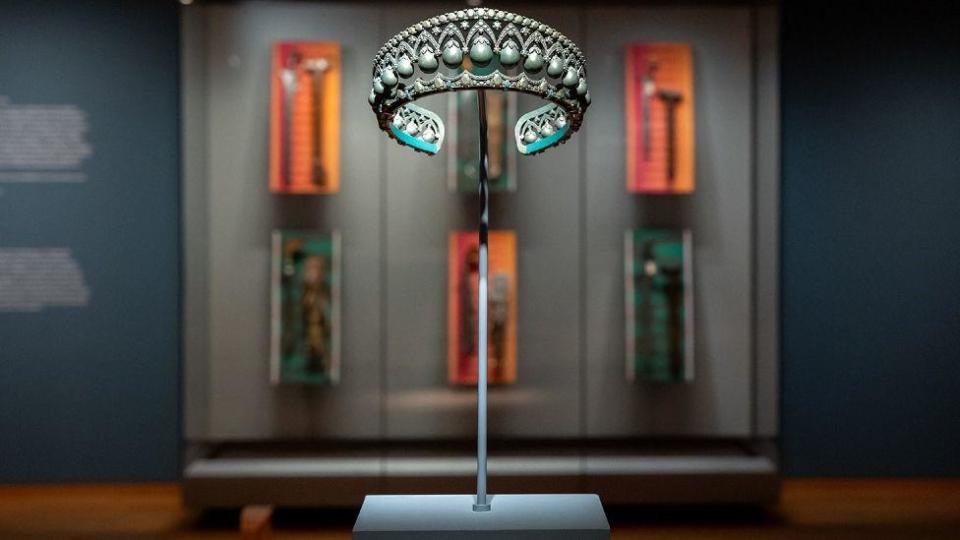

Manila-born Abad’s solo exhibition To Those Sitting in Darkness at the Ashmolean Museum in Oxford included drawings, etchings and sculptures that combined to “ask questions of museums”, according to the jury.
The 40-year-old, who works in London, reflects on colonial history and growing up in the Philippines, where his parents struggled against authoritarianism.
The title of his exhibit is a nod to Mark Twain’s 1901 essay To the Person Sitting In Darkness, which hit out at imperialism.
Jasleen Kaur
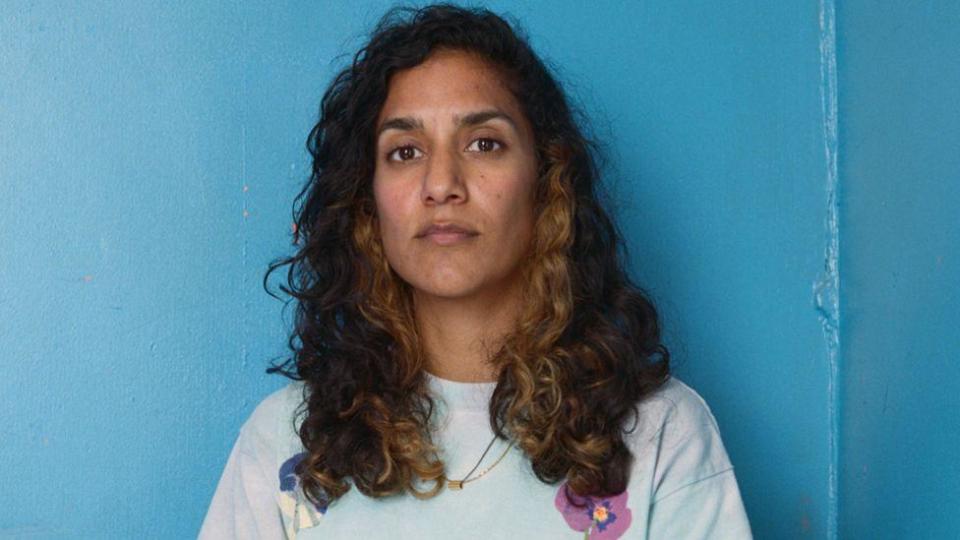



Kaur is on the list for Alter Altar at Tramway, Glasgow, which included family photos, an Axminster carpet, a classic Ford Escort covered in a giant doily, Irn-Bru and kinetic handbells.
The 37-year-old, who lives in London, had previously showcased her work at the Victoria and Albert Museum by looking at popular Indian cinema.
Delaine Le Bas


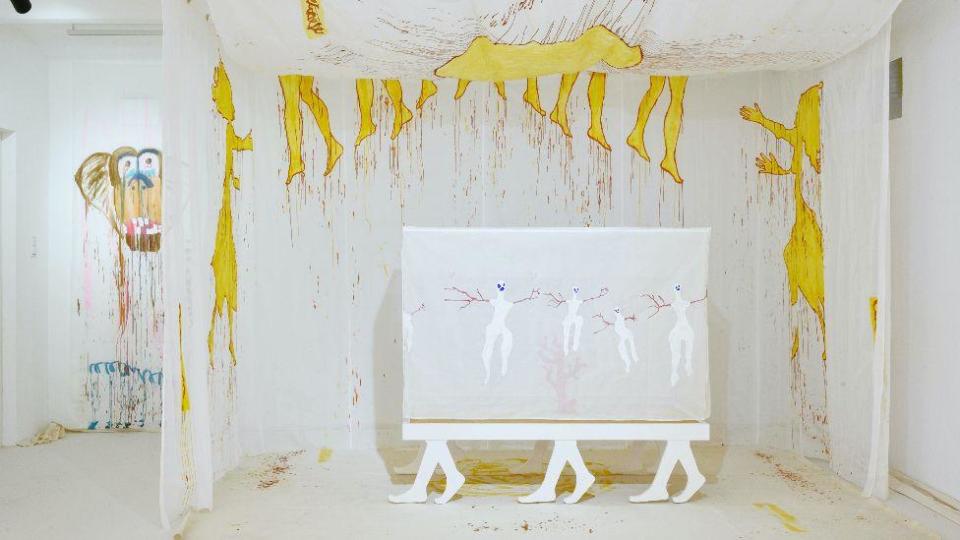

Worthing-born Le Bas is nominated for an exhibition titled Incipit Vita Nova. Here Begins The New Life/A New Life Is Beginning. Staged at the Secession art institute in Vienna, Austria, it saw painted fabrics hung, with theatrical costumes and sculptures also part of the exhibit.
The 58-year-old artist was inspired by the death of her grandmother and the history of the Roma people.
The jury said they “were impressed by the energy and immediacy present in this exhibition, and its powerful expression of making art in a time of chaos”.
Claudette Johnson


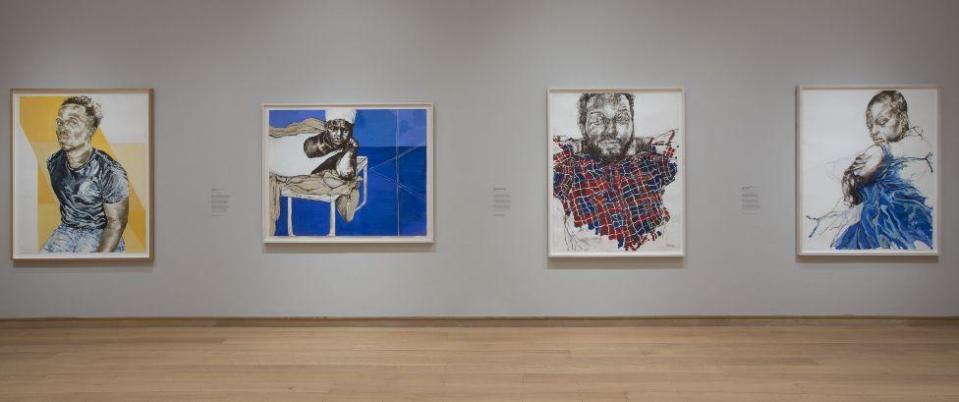

Manchester-born Johnson has been given the nod for her solo exhibition Presence at the Courtauld Gallery in London, and Drawn Out at Ortuzar Projects, New York.
She uses portraits of black women and men in a combination of pastels, gouache and watercolour, and was praised by the judges for her “sensitive and dramatic use of line, colour, space and scale to express empathy and intimacy with her subjects”.
Johnson, 65, was appointed an MBE in 2022 after being named on the New Year Honours list for her services to the arts.





Art
Turner Prize: Shortlisted artist showcases Scottish Sikh community
|
|
Turner Prize shortlist includes art showcasing Scottish Sikh community


A Scottish artist who uses cars, worship bells and Irn-Bru in her work is among the nominees for this year’s Turner Prize.
Glasgow-born Jasleen Kaur’s work reflects her life growing up in the city’s Sikh community.
She is up for the prestigious art award, now in its 40th year, alongside Pio Abad, Claudette Johnson and Delaine Le Bas.
Turner Prize jury chairman Alex Farquharson described it as a “fantastic shortlist of artists”
Works by the nominated artists will go on show at London’s Tate Britain gallery from 25 September.
They will receive £10,000 each, while the winner, to be announced on 3 December, will get £25,000.
In a statement, Farquharson said: “All four make work that is full of life.
“They show how contemporary art can fascinate, surprise and move us, and how it can speak powerfully of complex identities and memories, often through the subtlest of details.
“In the Turner Prize’s 40th year, this shortlist proves that British artistic talent is as rich and vibrant as ever.”
The shortlisted artists are:
Pio Abad
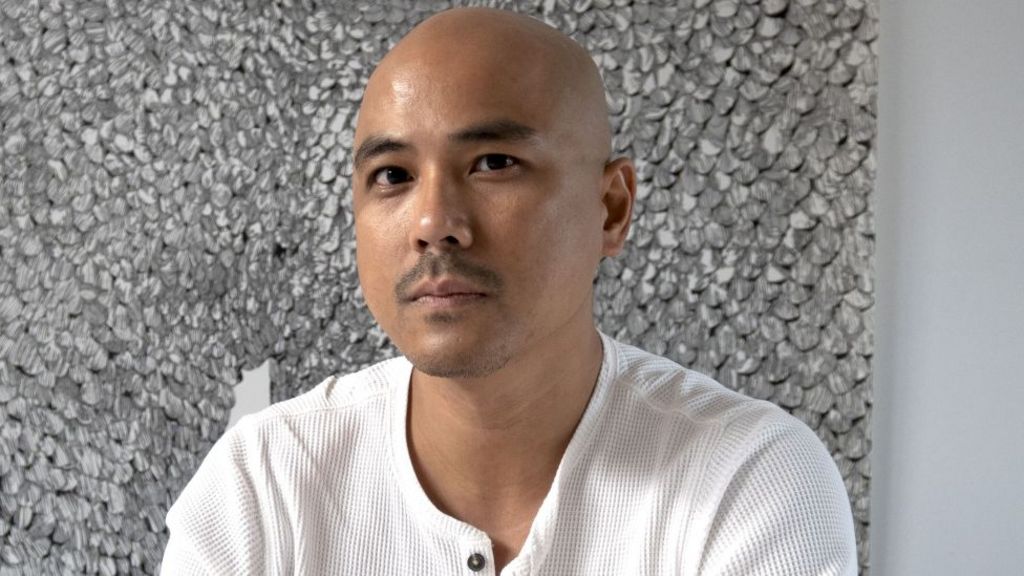

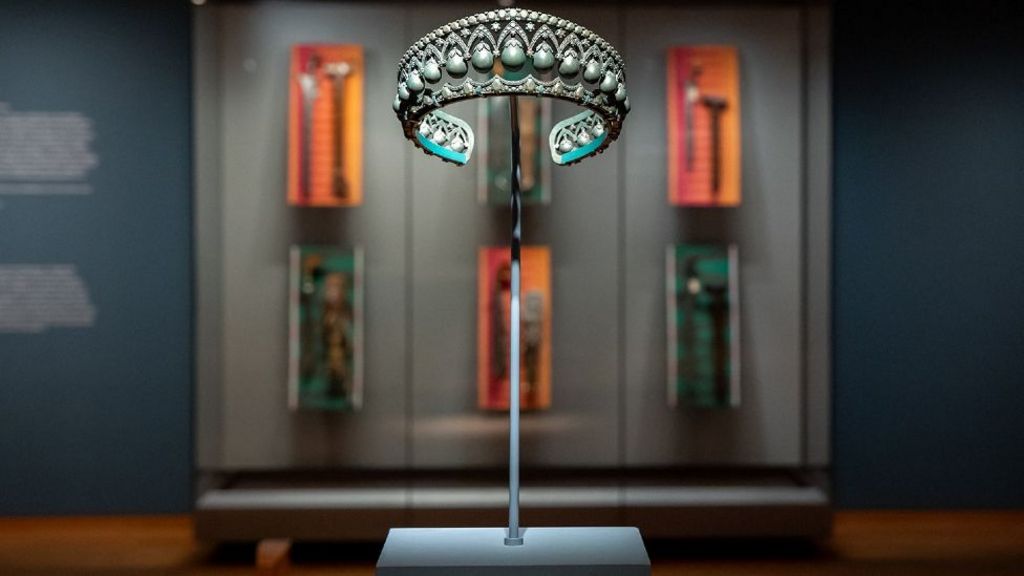

Manila-born Abad’s solo exhibition To Those Sitting in Darkness at the Ashmolean Museum in Oxford included drawings, etchings and sculptures that combined to “ask questions of museums”, according to the jury.
The 40-year-old, who works in London, reflects on colonial history and growing up in the Philippines, where his parents struggled against authoritarianism.
The title of his exhibit is a nod to Mark Twain’s 1901 essay To the Person Sitting In Darkness, which hit out at imperialism.
Jasleen Kaur
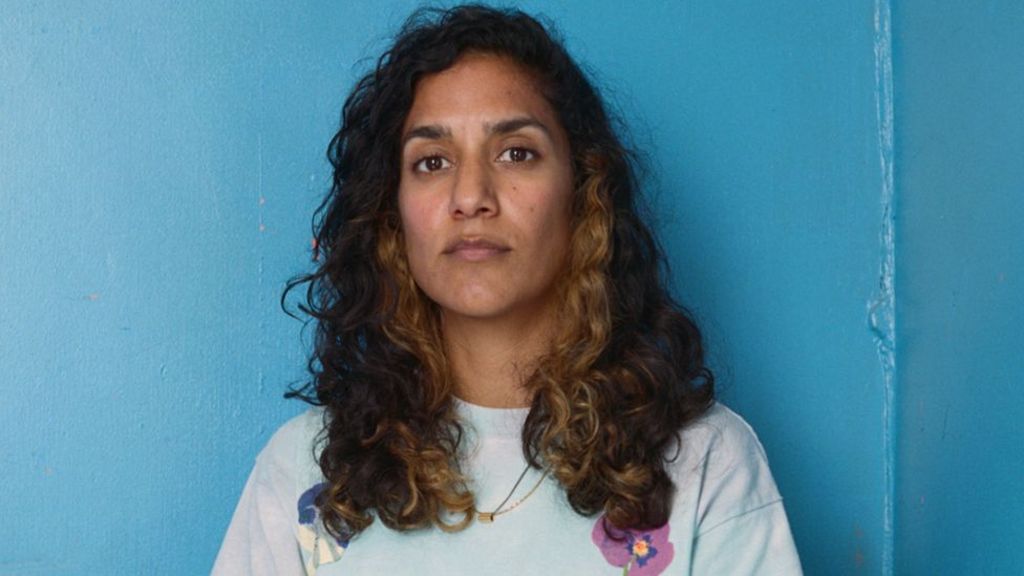



Kaur is on the list for Alter Altar at Tramway, Glasgow, which included family photos, an Axminster carpet, a classic Ford Escort covered in a giant doily, Irn-Bru and kinetic handbells.
The 37-year-old, who lives in London, had previously showcased her work at the Victoria and Albert Museum by looking at popular Indian cinema.
Delaine Le Bas
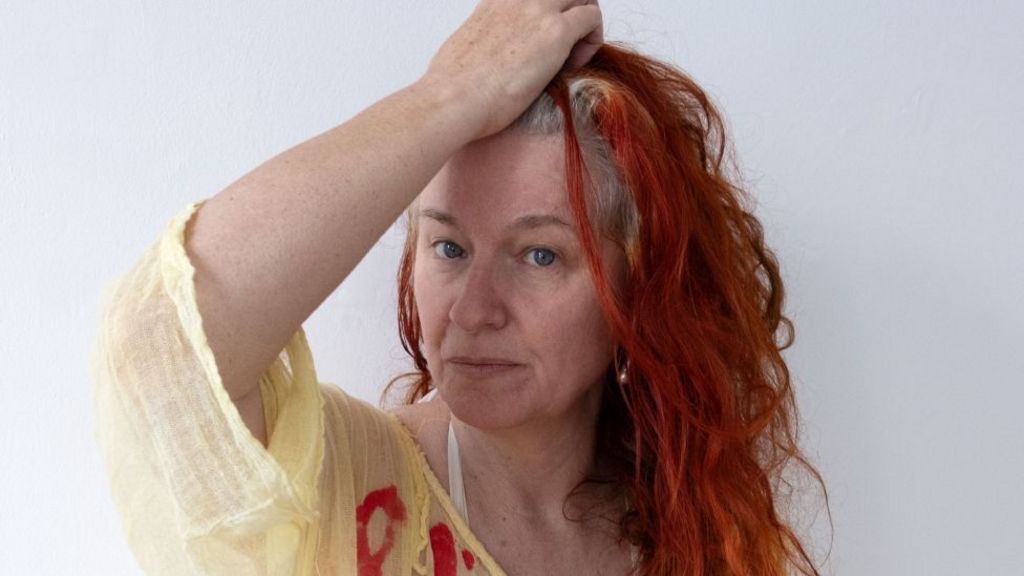



Worthing-born Le Bas is nominated for an exhibition titled Incipit Vita Nova. Here Begins The New Life/A New Life Is Beginning. Staged at the Secession art institute in Vienna, Austria, it saw painted fabrics hung, with theatrical costumes and sculptures also part of the exhibit.
The 58-year-old artist was inspired by the death of her grandmother and the history of the Roma people.
The jury said they “were impressed by the energy and immediacy present in this exhibition, and its powerful expression of making art in a time of chaos”.
Claudette Johnson
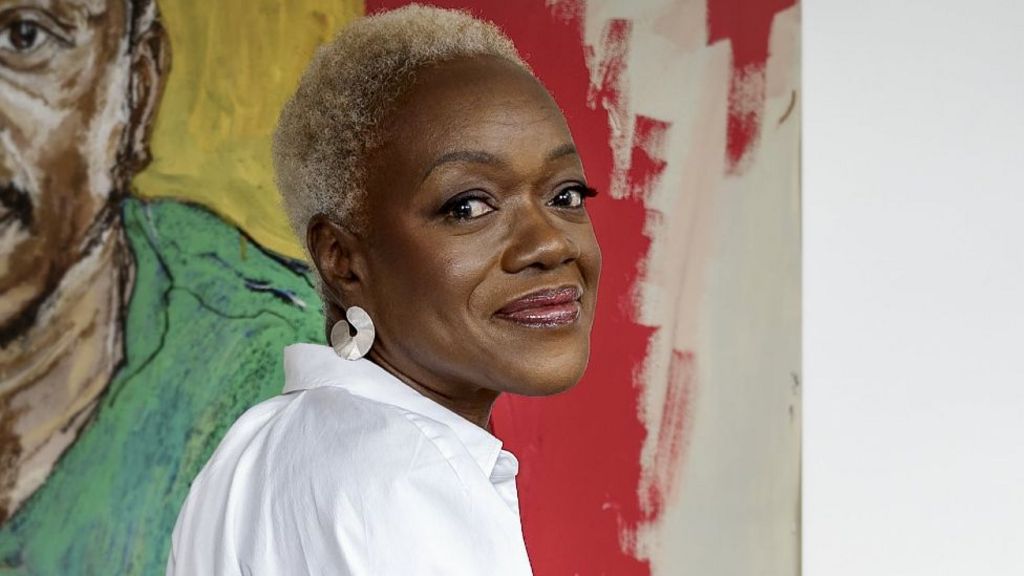

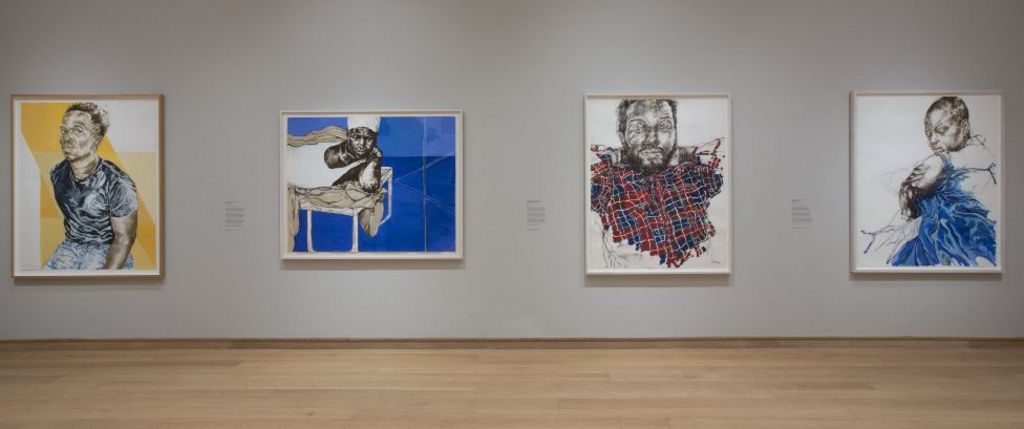

Manchester-born Johnson has been given the nod for her solo exhibition Presence at the Courtauld Gallery in London, and Drawn Out at Ortuzar Projects, New York.
She uses portraits of black women and men in a combination of pastels, gouache and watercolour, and was praised by the judges for her “sensitive and dramatic use of line, colour, space and scale to express empathy and intimacy with her subjects”.
Johnson, 65, was appointed an MBE in 2022 after being named on the New Year Honours list for her services to the arts.





-



 Politics23 hours ago
Politics23 hours agoPecker’s Trump Trial Testimony Is a Lesson in Power Politics
-



 Science23 hours ago
Science23 hours agoNASA Celebrates As 1977’s Voyager 1 Phones Home At Last
-
Media22 hours ago
B.C. puts online harms bill on hold after agreement with social media companies
-
Media16 hours ago
B.C. online harms bill on hold after deal with social media firms
-
Business22 hours ago
Oil Firms Doubtful Trans Mountain Pipeline Will Start Full Service by May 1st
-
Media21 hours ago
Trump poised to clinch US$1.3-billion social media company stock award
-



 Investment17 hours ago
Investment17 hours agoMOF: Govt to establish high-level facilitation platform to oversee potential, approved strategic investments
-



 Politics17 hours ago
Politics17 hours agoPolitics Briefing: Younger demographics not swayed by federal budget benefits targeted at them, poll indicates





